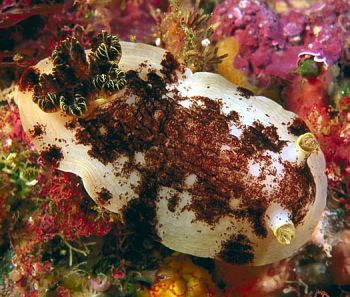

Aphelodoris luctuosa
(Cheeseman, 1882)
Order: NUDIBRANCHIA
Suborder: DORIDINA
Superfamily: EUDORIDOIDEA
Family: Dorididae
DISTRIBUTION
Throughout New Zealand from intertidal to 30-40m.
PHOTO
Poor Knights Islands, northeastern New Zealand in about 15 m of water. April, 2001. Lower photo showing prominently raised rhinophore pockets. Photo: Ian Skipworth.
This is one of a number of similarly coloured species found in New Zealand and southern Australia. How many species there are and their colour variability needs investigation.
Reference:
• Cheeseman, T.F. (1882 for 1881). On two new species of nudibranchiate Mollusca. Trans. Proc. New Zealand Inst., 14: 213-215
Rudman, W.B., 2000 (January 18) Aphelodoris luctuosa (Cheeseman, 1882). [In] Sea Slug Forum. Australian Museum, Sydney. Available from http://www.seaslugforum.net/find/apheluct
Related messages
Aphelodoris from New Zealand
January 12, 2010
From: Nova Mieszkowska

Hi again
Another species that you can hopefully id - I'm sending them all separately as per your website instructions.
Locality: Tonga Island Marine Reserve, Abel Tasman National Park, nthn tip of South Island, New Zealand, 10 January 2010, rocky intertidal. Length: 2 inches. Photographer: N Mieszkowska.
Many thanks,
Nova
nova@mba.ac.uk
Mieszkowska, N., 2010 (Jan 12) Aphelodoris from New Zealand. [Message in] Sea Slug Forum. Australian Museum, Sydney. Available from http://www.seaslugforum.net/find/23083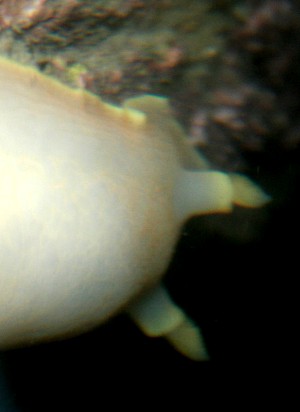
Dear Nova,
This is Aphelodoris luctuosa. As I discuss in an earlier message [#7490], it appears that southern specimens of this NZ species lack brown markings. In the close-up alongside, the raised rhinophore sheaths, which are characteristic of this genus are very onvious.
Best wishes,
Bill Rudman
Re: Aphelodoris? from sthn New Zealand
December 15, 2009
From: Amy Moran
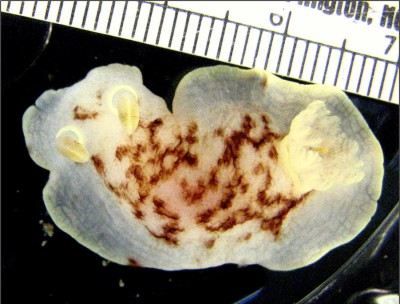
Concerning message #7490:
Hi Bill/Ian,
I collected this animal while diving around Wellington, and we and saw several others with a definite yellow margin and yellow tinting on the rhinophores and branchial plume (along with others that had no yellow). Interesting that this seems to be such a variable species.
Locality: Breaker Bay, Wellington, 25 feet, North Island, New Zealand, Pacific, 8 December 2009, Rock wall (photographed in lab). Photographer: Amy Moran.
Regards,
Amy
moran@clemson.edu
Moran, A., 2009 (Dec 15) Re: Aphelodoris? from sthn New Zealand. [Message in] Sea Slug Forum. Australian Museum, Sydney. Available from http://www.seaslugforum.net/find/22958Dear Amy,
Yes this is a species of Aphelodoris. It's possible there is more than one species in New Zealand waters but no one has investigated whether the colour variability is reflected in anatomical differences. At present Aphelodoris luctuosa is considered to be be the sole species occurring throughout New Zealand
Best wishes,
Bill Rudman
Re: Aphelodoris? from sthn New Zealand
February 6, 2008
From: Sharon Grant
Concerning message #7490:
Hi, we were diving this weekend in Whitireia Park, Wellington when we came across a nudibranch that looks very similar to this. Unfortunately I did not have my camera as I was taking open water training.
The shape with feathers and the two horns is almost identical but had two rather large splotches of brown/burgundy colour over the back. It was most definitely what I call, double layered as this picture.
I have never seen a nudibranch in Wellington at all so was very surprised to see this wandering across the sand in only 3.5 metres of water. Temp was 19 degrees. Great surprise for my new open water divers. Do you think that this could be an Aphelodoris?
Locality: Whitireia Park, Wellington, 3.5 metres, NZ, 02 February 2008, Sandy bottom. Length: 6-8cm
Sharon Grant
sharon@godeepscuba.co.nz
Grant, S., 2008 (Feb 6) Re: Aphelodoris? from sthn New Zealand. [Message in] Sea Slug Forum. Australian Museum, Sydney. Available from http://www.seaslugforum.net/find/21357Dear Sharon,
I am afraid it is difficult to be sure from your description. The 'horns' are the 'head tentacles' or rhinophores and the 'feathers' are their gills, but as both these characters are found in most dorid nudibranchs all I can really say is that you saw a dorid nudibranch. Your animal was possibly a colour form of Aphelodoris luctuosa but I am afraid the only way I can give you a sensible answer is to see a photo.
Best wishes,
Bill Rudman
Aphelodoris luctuosa? from nthn New Zealand
February 17, 2005
From: Alan Morrison
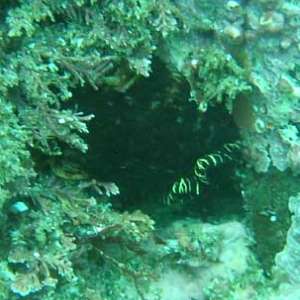
Dear Bill,
Thank you for your interest in my postings on Wade Doak's website.
The pictures were both taken in a small bay at Taiharuru, a few kilometers north of the entrance to Whangarei Harbour in January this year. The grapeweed slugs were in about 4-5 metres of water [message #13124] and this dark slug was farther out in about 8 metres and would have been 35-40mm long. I'm sorry I only managed to get one photo of it that came out.
See post on Wade Doak's website at: http://www.wadedoak.com/_disc1/0000045b.htm
Cheers,
Alan Morrison
aquaman@maxnet.co.nz
Morrison, A., 2005 (Feb 17) Aphelodoris luctuosa? from nthn New Zealand. [Message in] Sea Slug Forum. Australian Museum, Sydney. Available from http://www.seaslugforum.net/find/13126Dear Alan,
Its a bit difficult to make more than a guess. From the shape and colour of the gills, my best guess would be Aphelodoris luctuosa. Have a look at Mark Burnett's photo of a dark animal from the Poor Knight's [message #9402]. Its gills look very similar to those in your photo.
Best wishes,
Bill Rudman
Re: Aphelodoris luctuosa from New Zealand
March 25, 2003
From: Mark Burnett
Dear Bill,
reading Phil's message I naturally reviewed the slide in question, plus three others of the same animal. Sorry to disappoint (and relieved I hadn't missed something) but there is only the one animal in that picture. What you surmised could be gills is actually a piece of weed - I think Hormosira banksii. No idea what the "body" is but perhaps a small piece of shell?
Best regards
Mark Burnett
mburnett@actrix.gen.nz
Burnett, M., 2003 (Mar 25) Re: Aphelodoris luctuosa from New Zealand. [Message in] Sea Slug Forum. Australian Museum, Sydney. Available from http://www.seaslugforum.net/find/9479Thanks Mark,
Bill Rudman
Re: Aphelodoris luctuosa from New Zealand
March 21, 2003
From: Phil Cromwell
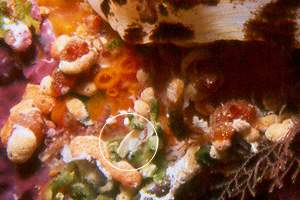
Bill,
In Mark's message it looks like there is a small yellow 'branch with dark spots in the lower left corner of the upper pic. It's hard to tell in this small of a picture.
Phil
chiron42@msn.com
Dear Phil,
It's always dangerous to look in the background of photos -you sometimes see things you missed in the field and wish you had seen. I've reproduced a section of Mark's original photo alongside and ringed the only thing that looks 'sluggy' to me. It could possibly be a juvenile Aphelodoris with darker gills, but that's only a guess.
Cheers,
Bill Rudman
Aphelodoris luctuosa from New Zealand
March 19, 2003
From: Mark Burnett
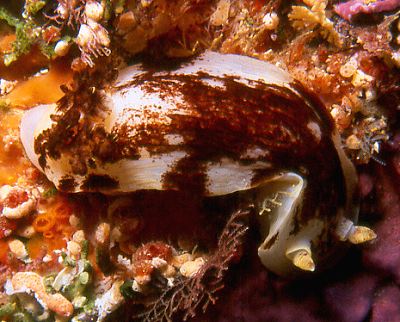
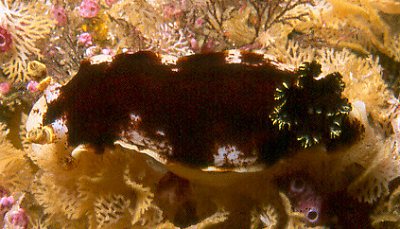
Hi Bill,
There seems to be an abundance of Aphelodoris luctuosa in northern New Zealand this year. I was interested in the discussion of colour variations especially considering the pictures from Ian Skipworth of the cream/white colour form. I'm almost tempted to theorise that the further north one goes in NZ, the darker A. luctuosa becomes. Diving at the Poor Knights this year this nudibranch has been present in abundance and I have only seen the dark brown, almost black colour form. The Hauraki Gulf seems to have a much lighter population of a tan colour. In the South Island, at Kaikoura, this nudibranch seems to be mainly white with small amounts of brown.
Unfortunately I don't have any slides from those locations. Of course it may just be that I missed any of a different colour variation at each of these places. I would be interested to learn of any other colour forms at these places.
Both picture were taken at Middle Arch, Poor Knights Ids. 8 March 2003. Depth was 18m and both animals were 7-8cm in length.
Regards,
Mark Burnett
mburnett@actrix.gen.nz
Burnett, M., 2003 (Mar 19) Aphelodoris luctuosa from New Zealand. [Message in] Sea Slug Forum. Australian Museum, Sydney. Available from http://www.seaslugforum.net/find/9402Thanks Mark,
I'm all in favour of theories like this, because it gives you and your colleagues something to prove or disprove. We call a gradual change in a character, like your suggesting, a cline. We ceratinly do see clinal changes in animal colouration, body size, bird song etc, so it would be interesting to find it in a nudibranch. It would certainly be worth getting your friends to look through old photo collections to see if a pattern emerges.
Best wishes,
Bill Rudman
Aphelodoris? from sthn New Zealand
July 13, 2002
From: Ian Skipworth
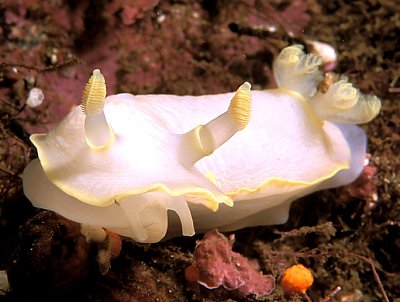

Hi Bill
Having recently completed a dive trip to Fiordland in south west of our South Island, I found quite a few of these nudibranchs. I was hoping that this would be a new nudibranch for me but suspect that it may simply be a colour variation of Aphelodoris luctuosa which is certainly very common in the north east of New Zealand.
I saw these nudis on many dives in shallowish water (7 to 20 metres). All were this colour - none had any brown in them. Your comments on its identification would be appreciated.
Thanks in advance
Ian
ian@ianskipworth.com
Skipworth, I., 2002 (Jul 13) Aphelodoris? from sthn New Zealand. [Message in] Sea Slug Forum. Australian Museum, Sydney. Available from http://www.seaslugforum.net/find/7490Dear Ian,
It certainly looks like an Aphelodoris with the raised sheath around the rhinophore stalk and the bushy gills. It looks like your earlier photos from nthn New Zealand with the brown removed. Richard Willan (In Willan & Coleman, 1984 - Nudibranchs of Australasia) mentions a colour form of A. luctuosa which is found at Stewart Island [sthn tip of South Island for those unfamiliar with NZ geography] which is 'dirty cream with a faint yellowish margin'.
Until this group is studied in more detail I think it is best to consider this to be a colour form of A. luctuosa. A. luctuosa is considered to occur all around New Zealand. It would certainly be useful to know just how its 'colour forms' are distributed around the country. I suspect there is not a lot of anatomical difference between species of this genus so in the end we will probably need to have information about the distribution of colour forms, what they eat, what their egg masss look like and how their eggs and larvae develop.
Cheers,
Bill Rudman
Mystery dorid from Leigh, New Zealand
October 9, 2001
From: Ian Paterson
Hello Dr. Rudman,
I am visiting NZ and have found a sponge-eating dorid that I am trying to identify. Can you recommend a key? I have looked in Willan & Morton (1984) and Morton & Miller but have not yet settled on a species (or even a genus). I collected a grey sponge while snorkeling near Leigh [north of Auckland, New Zealand](don't know the species - I was looking for a polychaete known to live in Ancorina sponges but am not certain the sponge I have is actually Ancorina). The sponge has many (~50)dorids on it. About 2 to 3 mm in length (could be juveniles?), white body with small reddish brown spots on the mid-dorsal surface. Rhinophores white with variable amounts of red-brown colour on only the inner sides, never extending to the tip. The rhinophores appear to be smooth, with a very slight inflation in the distal third. Branchiae very small - not obvious, often held retracted.
Any suggestions as to a key to species or even 'give up they are babies' would be appreciated.
Thanks
Ian Paterson
i.paterson@auckland.ac.nz
Paterson, I., 2001 (Oct 9) Mystery dorid from Leigh, New Zealand. [Message in] Sea Slug Forum. Australian Museum, Sydney. Available from http://www.seaslugforum.net/find/5428Dear Ian,
At that size I suspect they are juveniles. You don't mention whether their backs are smooth, spiculate, warty, or otherwise sculptured. On the basis that they are smooth, my guess would be they are juvenile Aphelodoris luctuosa which is one of the commonest subtidal dorids in that part of New Zealand. As that species grows to about 80mm, your animals would lack some of the finer details if they are indeed juveniles.
A large cluster of juveniles like this is often an indication of a species with non-planktonic larvae, juveniles benthic slugs hatching directly from their egg mass. As far as I know the development strategy of Aphelodoris luctuosa has never been reported so that is not much help. I assume you are at the Marine Lab at Leigh. If so, perhaps you should try to keep the animals alive on the sponge for a while and see if they will grow to a more identifiable size. If you can take a photo that might help me to identify them.
The reference you mention:
• Willan, R. & Morton, J. (1984) Marine Molluscs. Part 2. Opisthobranchia. Leigh Marine Laboratory, University of Auckland, New Zealand.
is the most useful reference. The fauna is not that large as to makea key necessary.
Sorry I can't be more help,
Best wishes,
Bill Rudman
Aphelodoris luctuosa from New Zealand
May 13, 2001
From: Ian Skipworth
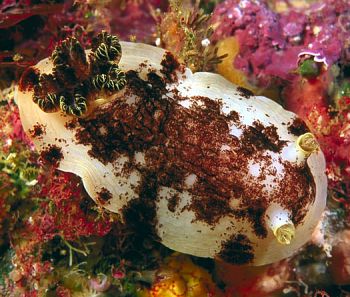
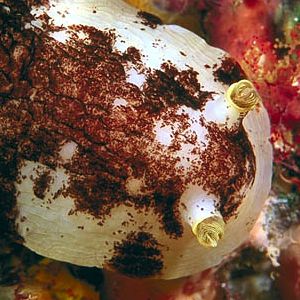
Bill
Thank you very much for your identification of my Hypselodoris kaname snap.
I see that you are looking for a photograph of Aphelodoris luctuosa and thought I would send you one. This was photographed in April this year at the Poor Knights Islands in about 15 m of water. We see these very regularly around the north eastern NZ coast.
Thanks again
Ian
Skipworth, I.
ian@ianskipworth.com
Skipworth, I., 2001 (May 13) Aphelodoris luctuosa from New Zealand. [Message in] Sea Slug Forum. Australian Museum, Sydney. Available from http://www.seaslugforum.net/find/4332Thanks Ian,
It's nice to see these photos of the New Zealand fauna. I had forgotten how raised the rhinophore pockets are (bottom photo).
Bill Rudman
Aphelodoris from New Zealand
January 19, 2000
From: Erwin Koehler
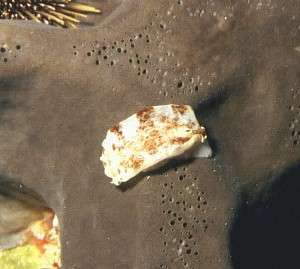
Bill,
A Happy New Year to you and all visitors of the SEA SLUG FORUM.
Here is one from New Zealand, Poor Knights Is., 10m depth, size about 4cm. It was made by Gerhard Ramsch in 1995.
Please, can you identify it?
Erwin
Medslugs.Koehler@t-online.de
Koehler, E., 2000 (Jan 19) Aphelodoris from New Zealand. [Message in] Sea Slug Forum. Australian Museum, Sydney. Available from http://www.seaslugforum.net/find/1748Dear Erwin,
I am pretty sure this is Aphelodoris luctuosa which is one of the commonest subtidal dorids in northern New Zealand. There are a number of very similar looking species of Aphelodoris in New Zealand and southern Australia.
Best wishes,
Bill Rudman.
